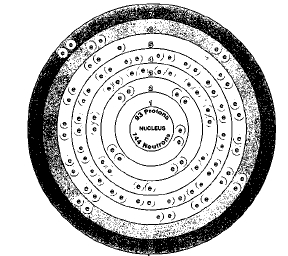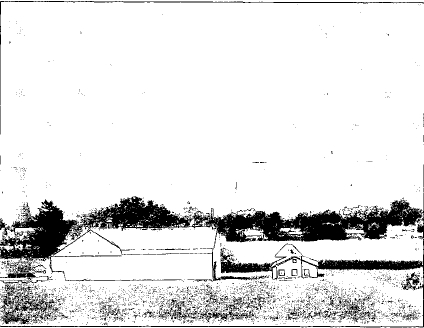NEPTUNIUM


Overview
Neptunium lies in Row 7 of the periodic table. The periodic table is a chart that shows how chemical elements are related to one another. Neptunium is the first transuranium element. The term transuranium means "beyond uranium." Any element with an atomic number greater than 92 (uranium's atomic number) is called a transuranium element. Elements in Row 7 are also called actinide elements. This name comes from the first element in Row 7, actinium.
Scientists have now found about 18 isotopes of neptunium. They are all radioactive. Neptunium was once a very rare element, but it can now be somewhat easily produced in a nuclear reactor. A nuclear reactor is a device in which nuclear fission reactions occur. Nuclear fission is the process of splitting atoms when neutrons collide with atoms of uranium or plutonium. These collisions produce new elements. Neptunium is used commercially only in specialized detection devices.
SYMBOL
Np
ATOMIC NUMBER
93
ATOMIC MASS
237.0482
FAMILY
Actinide
Transuranium element
PRONUNCIATION
nep-TOO-nee-um
Discovery and naming
The discovery of neptunium in 1940 represented an important breakthrough in the study of chemical elements. Scientists had known for nearly a decade about an unusual kind of reaction.

When an element is bombarded with neutrons, it sometimes changes into a new element. That new element has an atomic number one greater than the original element. For example, bombarding copper (atomic number 29) with neutrons may result in the production of zinc (atomic number 30). Bombarding sodium (atomic number 11) with neutrons may result in magnesium (atomic number 12).
One reason this discovery fascinated scientists was the possibility of bombarding uranium (atomic number 92) with neutrons. In the 1930s, uranium was the heaviest element known. It was the last element in the periodic table. But a "neutron change" like the ones described above would produce an element with atomic number 93. No one had ever heard of an element with atomic number 93!
In 1940, a pair of physicists at the University of California at Berkeley were studying this problem. Edwin M. McMillan (1907–91) and Philip H. Abelson (1913–) reported finding evidence of element number 93. They suggested naming it neptunium, in honor of the planet Neptune. (Uranium, the element before neptunium, had been named for the planet Uranus.)
Physical and chemical properties
Neptunium is a silvery white metal with a melting point of 640°C (1,180°F) and a density of 20.45 grams per cubic centimeter.
Chemical properties
Neptunium is fairly reactive and forms some interesting compounds. Examples include neptunium dialuminide (NpAL 2 ) and neptunium beryllide (NpBe 3 ). These compounds are unusual because they consist of two metals joined to each other. Normally, two metals do not react with each other very easily. Neptunium also forms a number of more traditional compounds, such as neptunium dioxide (NpO 2 ), neptunium trifluoride (NpF 3 ), and neptunium nitrite (NpNO 2 ).
Occurrence in nature
When neptunium was first discovered, scientists thought it was an entirely artificial, or man-made, element. In 1942, very small amounts of the element were found in the Earth's crust. The element can sometimes be found in ores containing uranium and other radioactive elements.
Isotopes
All isotopes of neptunium are radioactive. Isotopes are two or more forms of an element. Isotopes differ from each other according to their mass number. The number written to the right of the element's name is the mass number. The mass number represents the number of protons plus neutrons in the nucleus of an atom of the element. The number of protons determines the element, but the number of neutrons in the atom of any one element can vary. Each variation is an isotope.
A radioactive isotope is one that breaks apart and gives off some form of radiation. Radioactive isotopes are produced when very small particles are fired at atoms. These particles stick in the atoms and make them radioactive.
The longest lived isotope is neptunium-237. Its half life is 2,140,000 years. The half life of a radioactive element is the time it takes for half of a sample of the element to break

Neptunium-239 is the only isotope of neptunium to have practical uses. It is used in special instruments for detecting the presence of neutrons.
Extraction
Pure neptunium metal can be made by heating neptunium trifluoride (NpF
3
) with hot barium or lithium metal:
The metal can now be purchased for Legal uses from the Oak Ridge National Laboratory in Oak Ridge, Tennessee.
The case of the disappearing elements
S cientists think that the Earth was formed about five billion years ago. What elements would a chemist have found on the Earth in those days?
Part of the answer to that question is easy. Most of the elements found today were probably present five billion years ago. Those are the stable, or constant, elements. An untouched lump of gold in the Earth's crust five billion years ago would still be a lump of gold today.
But that statement is not true for radioactive elements. Radioactive elements "fall apart" spontaneously. They break down and form new, simpler elements.
The rate at which radioactive elements break down differs from element to element, however. Some break down slowly, others break down quickly. Scientists measure the rate of breakdown in half lives. An element with a long half life breaks down very slowly. An element with a short half life breaks down quickly.
Uranium, for example, has three naturally occurring isotopes. Their half lives are 4.6 billion years, 700 million years, and 25 million years. If 100 metric tons of uranium were present when the Earth was formed five billion years ago, about half of the first isotope would have broken down by now. About 50 metric tons of the element would remain. Scientists would have no trouble finding the element in the Earth's crust.
But neptunium is a different story. Its longest lived isotope is neptunium-237, with a half life of about two million years. If 100 million tonnes of neptunium were present at the Earth's beginning, only 50 million tons would be left after two million years. After another two million years (four million years altogether), only 25 million tons would be left. After another two million years (six million years altogether), only 12.5 million tons would be left.
Continue the mathematics. How much neptunium is left after 8 million years, 10 millions years, 12 million years, ... 5 billion years? No need to do the calculations: Not very much neptunium at all would be left! Perhaps, too little to even find in the Earth's crust.
So what does this example suggest about other transuranium elements, such as plutonium (number 94) and americium (number 95)? All of these elements have fairly short half lives. Of course, "fairly short" sometimes means "only" a few million years!
Uses and compounds
Neptunium and its compounds of neptunium have been made for research purposes. They are used in specialized detection devices and in nuclear reactors. Neither the element nor its compounds have any commercial uses.
Neptunium is a very hazardous material. It must be handled with great caution.
Health effects
Neptunium is a very hazardous material. The radiation it gives off can cause serious health problems for humans and animals. It must be handled with great caution. Radiation transfers large amounts of energy to cells and is quite penetrating. Cells that are damaged, but not killed, often reproduce out of control. This growth by functionally damaged cells forms tumors and causes related problems for organs and tissues.
Linking with the research mostly appreciative